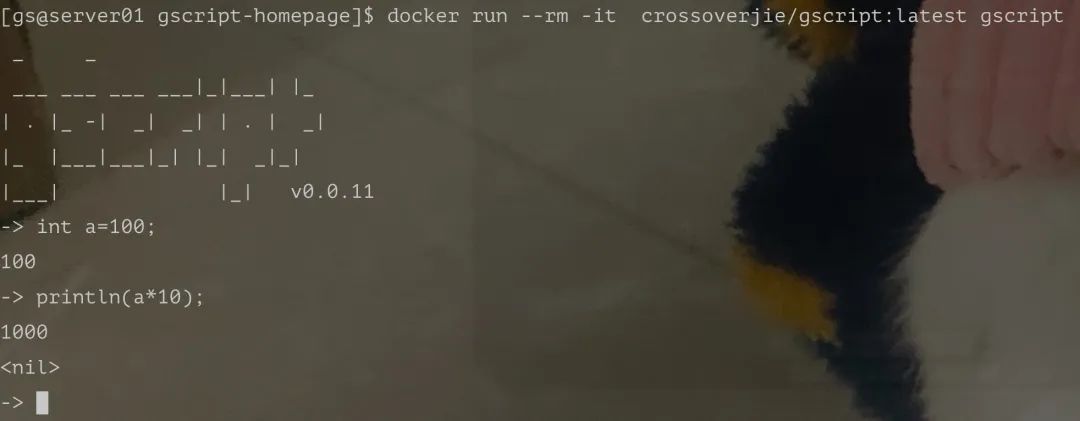社区精选 |手写编程语言-如何为 GScript 编写标准库
今天小编为大家带来的是社区作者 crossoverJie 的文章,让我们一起来学习如何为 GScript 编写标准库。
版本更新
最近 GScript 更新了 v0.0.11 版本,重点更新了:
Docker 运行环境
新增了 byte 原始类型
新增了一些字符串标准库 Strings/StringBuilder
数组切片语法:int[] b = a[1: len(a)];
具体更新内容请看下文。
前言
前段时间发布了 GScript 的在线 playground,

这是一个可以在线运行 GScript 脚本的网站,其本质原理是接收用户的输入源码从而在服务器上运行的服务;这简直就是后门大开的 XSS 攻击,为保住服务器我设置了运行 API 的后端服务的用户权限,这样可以避免执行一些恶意的请求。
但也避免不了一些用户执行了一些耗时操作,比如一个死循环、或者是我提供 demo 里的打印杨辉三角。

这本质上是一个递归函数,当打印的三角层数过高时便会非常耗时,同时也非常消耗 CPU。
有几次我去检查服务器时发现了几个 CPU 过高的进程,基本上都是这样的耗时操作,不可避免的会影响到服务器的性能。
使用 Docker
为了解决这类问题,很自然的就能想到可以使用 Docker,所有的资源都和宿主机是隔离开的,无论怎么瞎折腾也不会影响到宿主机。
说干就干,最后修改了 API 执行脚本的地方:
string fileName = d.unix("Asia/Shanghai") + "temp.gs" ;
s.writeFile(fileName, body, 438);
string pwd = s.getwd();
// string res = s.command("gscript", fileName);
string res = s.command("docker","run","--rm","-v", pwd+":/usr/src/gscript","-w","/usr/src/gscript", "crossoverjie/gscript","gscript", fileName);
s.remove(fileName);
r.body = res;
r.ast = dumpAST(body);
r.symbol=dumpSymbol(body);
ctx.JSON(200, r);
主要修改的就是将直接执行的 GScript 命令修改为了调用 docker 执行。
但其实也还有改进空间,后续新增协程之后可以便可监控运行时间,超时后便会自动 kill 进程。
我也将该 Docker 上传到了 DockerHub,现在大家想在本地体验 GScript 的 REPL 时也只需要运行Docker 就能使用。
docker pull crossoverjie/gscript
docker run --rm -it crossoverjie/gscript:latest gscript

当然也可以执行用 Docker 执行 GScript 脚本:
docker run --rm -v $PWD:/usr/src/gscript -w /usr/src/gscript crossoverjie/gscript gscript {yourpath}/temp.gs
编写 GScript 标准库

// 字符串工具类
StringBuilder b = StringBuilder();
b.writeString("10");
b.writeString("20");
int l = b.writeString("30");
string s = b.String();
printf("s:%s, len=%d ",s,l);
assertEqual(s,"102030");
byte[] b2 = toByteArray("40");
b.WriteBytes(b2);
s = b.String();
assertEqual(s,"10203040");
println(s);
// Strings 工具类
Strings s = Strings();
string[] elems = {"name=xxx","age=xx"};
string ret = s.join(elems, "&");
println(ret);
assertEqual(ret, "name=xxx&age=xx");
bool b = s.hasPrefix("http://www.xx.com", "http");
println(b);
assertEqual(b,true);
b = s.hasPrefix("http://www.xx.com", "https");
println(b);
assertEqual(b,false);
其中的实现源码基本上是借鉴了 Go 的标准库,先来看看 StringBuilder 的源码:
class StringBuilder{
byte[] buf = [0]{};
// append contents to buf, it returns the length of s
int writeString(string s){
byte[] temp = toByteArray(s);
append(buf, temp);
return len(temp);
}
// append b to buf, it returns the length of b.
int WriteBytes(byte[] b){
append(buf, b);
return len(b);
}
// copies the buffer to a new.
grow(int n){
if (n > 0) {
// when there is not enough space left.
if (cap(buf) - len(buf) < n) {
byte[] newBuf = [len(buf), 2*cap(buf)+n]{};
copy(newBuf, buf);
buf = newBuf;
}
}
}
string String(){
return toString(buf);
}
}
class Strings{
// concatenates the elements of its first argument to create a single string. The separator
// string sep is placed between elements in the resulting string.
string join(string[] elems, string sep){
if (len(elems) == 0) {
return "";
}
if (len(elems) == 1) {
return elems[0];
}
byte[] bs = toByteArray(sep);
int n = len(bs) * (len(elems) -1);
for (int i=0; i < len(elems); i++) {
string s = elems[i];
byte[] bs = toByteArray(s);
n = n + len(bs);
}
StringBuilder sb = StringBuilder();
sb.grow(n);
string first = elems[0];
sb.writeString(first);
string[] remain = elems[1:len(elems)];
for(int i=0; i < len(remain); i++){
sb.writeString(sep);
string r = remain[i];
sb.writeString(r);
}
return sb.String();
}
// tests whether the string s begins with prefix.
bool hasPrefix(string s, string prefix){
byte[] bs = toByteArray(s);
byte[] bp = toByteArray(prefix);
return len(bs) >= len(bp) && toString(bs[0:len(bp)]) == prefix;
}
}
GScript 源码:https://github.com/crossoverJie/gscript Playground 源码:https://github.com/crossoverJie/gscript-homepage GScript Docker地址:https://hub.docker.com/r/crossoverjie/gscript


关注公众号:拾黑(shiheibook)了解更多
赞助链接:
关注数据与安全,洞悉企业级服务市场:https://www.ijiandao.com/
四季很好,只要有你,文娱排行榜:https://www.yaopaiming.com/
让资讯触达的更精准有趣:https://www.0xu.cn/
 关注网络尖刀微信公众号
关注网络尖刀微信公众号随时掌握互联网精彩
- 安卓B站非官方客户端PiliPala收到侵权律师函 开发者宣布停止开发工作
- Lapce 采用 Rust 语言编写的代码编辑器
- 微信推出这个送礼功能 到底好不好用
- K2CMS模版更新 如初上线 https://qinggan.ijiandao.com/
- 日本量子技术科技战略研究
- 关于“算力”,这篇文章值得一看
- 美国防创新小组近期主要研究项目及成果应用影响
- 中国信通院:5月份国内市场手机出货量2080.5万部,同比下降9.4%
- 云从流血上市,未来何去何从?
- 机器人警告,有点复杂,有点大用
- TikTok 被指控“违反” OBS 相关 GPL 协议?或因新 Live Studio 直播应用程序而陷争议
- 新造车势力让华为走开









 微信扫码关注公众号
微信扫码关注公众号